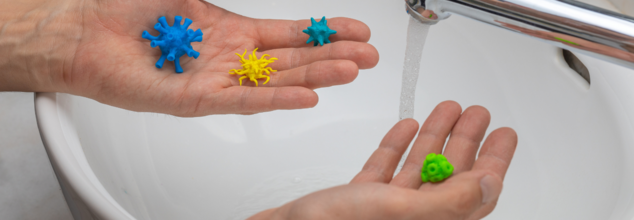- Health Conditions A-Z
- Health & Wellness
- Nutrition
- Fitness
- Health News
- Ayurveda
- Videos
- Medicine A-Z
- Parenting
- Web Stories

Credits: Canva
What Is Hantavirus That Killed Gene Hackman's Wife, Betsy Arakawa?
Health officials in New Mexico confirmed on Friday that the reason for Betsy Arakawa, Gene Hackman's wife's death was hantavirus infection.
Hantavirus if found throughout the world, and is spread by contact with rodents or their urine or feces. However, it does not spread between people. The cause of concern is there is no specific treatment or cute, though early medical attention can increase the chances of survival.
What Is Hantavirus?
As per the Centers for Disease Control and Prevention (CDC). hantavirus are a family of viruses which can cause serious illnesses and death. These viruses are capable of causing diseases like hantavirus pulmonary syndrome or HPS and hemorrhagic fever with renal syndrome or HERS.
It can infect and cause serious disease in people. It has mainly two syndromes. One is found in the Western Hemisphere, including in the US, that can cause HPS. The most common hantavirus that causes HPS in the US is spread by the deer mouse. HERS is a group which is similar illness caused by hantaviruses and found mostly in Asia and Europe. There's another type, called the Seoul virus, which is a type of hantavirus that causes HERS, and is found worldwide, including in the US.
The majority of U.S. cases since then have been in western states, especially the southwest. Between 1993 and 2022, there were 864 reported U.S. cases. New Mexico had the highest number over that time, at 122, followed by Colorado at 119.
The CDC has offered to test samples related to Arakawa's case to better understand the strain of the virus that infected her and to conduct pathology testing.
What Are The Common Symptoms?
According to the CDC, symptoms can appear one to eight weeks after exposure, initially presenting as fatigue, fever, and muscle aches. As the disease progresses, it can cause coughing, shortness of breath, and chest tightness as fluid accumulates in the lungs. The CDC reports that about one-third of individuals who develop respiratory symptoms from the disease may not survive.
Despite extensive research, many questions remain unanswered, including why some cases are mild while others become severe and how antibodies develop. She and other researchers have been tracking patients over extended periods, hoping to uncover potential treatments.
How Can You Reduce Your Risk?
You can reduce your risk by eliminating and minimizing your contacts with rodents in your home, workplace or campsite. The best way is to seal holes and gaps in your home or garage and keep the rodents from entering you home. You can also place traps in and around your home to decrease rodent infestation. Clean up any easy to get food that could attract rodents.
How Does The Diagnosis Work?
CDC notes that the diagnosis in a person who has been infected less than 72 hours is difficult. If the initial test is done before the virus can be found, then a repeat test is required after 72 hours whenever the symptoms start to show up. Early symptoms, as mentioned above, like fever, headache, muscle aches, nausea and fatigue could also be easily confused with influenza, thus a test is extremely important.

Credits: Canva
How To Know If You Have A Cold Or A Pollen Allergy?
Spring is a beautiful time, but it often brings along runny noses, sneezing, and congestion. These symptoms can easily be mistaken for either a cold or seasonal allergies. Both share overlapping traits, but they stem from entirely different causes. A cold is caused by a virus, making it infectious, while seasonal allergies are your immune system’s reaction to harmless substances like pollen.
In many parts of the world, it is also the time when seasonal changes are occurring. With shorter springs, longer summers, or the transition in between, pollen is everywhere. However, it does not mean that other common virus and bacteria are gone. So, how do you differentiate between them, especially when you get sick? How do you know when you have a cold or an allergy.
Let us check this out!
What Are Seasonal Allergies?
Seasonal allergies, also known as hay fever or allergic rhinitis, happen when your immune system mistakenly sees pollen as a threat and releases chemicals like histamines to fight it. This overreaction leads to sneezing, a runny or stuffy nose, itchy eyes, and sometimes throat irritation.
Different types of pollen trigger allergies depending on the season. In spring, tree pollen is the main culprit. As the year progresses, grass and weed pollens take over. Due to rising global temperatures, allergy seasons are starting earlier and lasting longer than before.
What Is a Cold?
A cold is typically caused by viruses like the rhinovirus and is more common during seasonal transitions. It spreads easily through the air or by touching contaminated surfaces. Cold symptoms often include a sore throat, fatigue, congestion, sneezing, and a runny nose. You may also experience body aches and a mild fever.
Unlike allergies, which persist for weeks or even months, colds usually last between three and seven days for most healthy individuals.
Key Differences Between a Cold and Allergies
Despite their similarities, colds and allergies have a few clear distinctions:
Duration: A cold is short-lived, usually resolving within a week. Allergies persist throughout the pollen season.
Itchiness: Allergies commonly cause itchy eyes and throat. Colds may bring soreness but rarely itchiness.
Fever and Body Aches: Colds can come with mild fever and aches. Allergies do not.
Contagiousness: Colds are infectious; allergies are not. If you’re sneezing and spreading droplets, you could pass on a cold.
Mucus Color: Colds may lead to yellow or green mucus. Allergy mucus tends to stay clear.
Treating Seasonal Allergies
To manage allergy symptoms:
- Use saline nasal rinses to clear allergens.
- Apply anti-itch eye drops for relief.
- Take over-the-counter antihistamines or corticosteroid nasal sprays.
- Track local pollen levels and avoid high-pollen days.
- If symptoms persist despite self-care, consult a healthcare provider.
Treating a Cold
There’s no quick fix for a cold, but you can ease symptoms by:
- Getting plenty of rest.
- Drinking fluids to stay hydrated.
- Avoiding contact with others to prevent spreading the virus.
- Recovery usually comes with time and supportive care.

Credits: Canva
Plea of Chilean Woman With Muscular Dystrophy Sparks National Debate on Euthanasia Bill
Susana Moreira, a 41-year-old woman from Santiago, Chile, has lived with a debilitating form of muscular dystrophy since childhood. She was diagnosed with this condition at the age of 8. Her condition has been progressive since then. As a result, she was bedridden for over 20 years. She was once able to move, but can now no longer walk, bathe, or care for herself.
Her muscles have continued to weaken and she is expected to eventually lose the ability to speak and breathe without help.
What Happens In Muscular Dystrophy?
As per the National Institute of Neurological Disorders and Stroke, muscular dystrophy or MD refers to a group of genetic diseases that cause progressive weakness and degeneration of skeletal muscles. These disorders vary in age of onset, severity, and the pattern of affected muscle. However, one thing that is definite is that this condition is progressive in nature.
As per NIH, it affects by weakening the muscles. Muscles are made of thousands of fibers and these fibers contain cells surrounded by an outer layer of membrane. Muscle fibers that make these individual muscles are bound together by connective tissue. Muscles are activated when an impulse, or signal is sent from the brain. What happens in MD is the protective membrane of the muscle is damaged and the muscle fibers begin to leak protein creatine kinase and take excess calcium. This damages the muscle fibers and then causes the fibers to die, and thus leads to progressive muscle degeneration.
Right To Die
Moreira, is also facing the same condition, which will eventually make her unable to live with dignity. Therefore, she wants to be able to choose a dignified death, though euthanasia.
However, euthanasia and assisted dying are currently illegal in Chile. Her deeply personal plea has reignited a national conversation and become a symbol of the push for legal reform.
The Bill Is Stuck
Chile’s debate over euthanasia is not new. In 2021, the Chamber of Deputies approved a bill to allow both euthanasia and assisted suicide for adults suffering from terminal or incurable illnesses. But the legislation has since stalled in the Senate.
If passed, Chile would join countries like Belgium, Spain, Canada, and the Netherlands in legalizing both practices. In Latin America, Colombia already allows euthanasia, and Ecuador recently decriminalized it, though regulations are still pending.
Speaking Out Before It's Too Late
Confined to her home, Moreira spends her days reading, watching movies, and playing video games. Outings are rare due to the pain caused by sitting in a wheelchair for too long. In a letter to President Gabriel Boric, she urged him to support the bill and shared her fears about reaching a stage where she could no longer communicate her wishes.
President Boric responded publicly, calling the bill “an act of empathy, responsibility and respect,” and promised to prioritize it in his final year in office. However, political turmoil has since pushed the issue to the sidelines.
A Growth In Support
While Chile was once considered one of Latin America’s most conservative nations, attitudes toward euthanasia have shifted. A 2024 Cadem survey found that 75% of Chileans support euthanasia. Another study by the Center for Public Studies reported 89% support for allowing it either always or in special cases.
Supporters argue the law would offer people suffering from terminal conditions a humane and legal option. Critics, however, say better access to palliative care must come first. Chile passed a law in 2022 guaranteeing palliative care, but experts argue its implementation is uneven.
The debate has also been shaped by other moving stories, such as that of Valentina Maureira, a teen who pleaded publicly for euthanasia in 2015 but was denied and died shortly after.

(Credit-Canva)
Things In Your Home That You May Not Be Cleaning Enough
When it comes to keeping your home clean, people do not leave any stone unturned. Our parents would often nag us to clean our rooms and keep the house clean. While it would annoy us to no end, growing up we understood why they encouraged us to keep the place we live in clean. It's not just about making it look good, but also about protecting it from harmful bacteria and germs.
While your home may be your personal space, it can quickly become a breeding ground for germs. You are also more likely to fall sick due to an unhygienic space as you spend a lot of time at home, including resting and sleeping.
However, while you may clean your floors, your closet and the washroom frequently, there are many unsuspecting items that are not cleaned as often, sometimes not at all. These items are mostly used daily, and do not need to be cleaned daily. As insignificant these may seem, periodically cleaning them is necessary to stop them from becoming breeding grounds for health issues.
Unlikely Things That Get Neglected Being Cleaned
Sponges and Dish Cloths
Before tackling dishes or counters, remember your sponge and cloth can be very unclean. They collect food scraps and messes, creating a damp home for harmful bacteria that soap alone won't eliminate. A study published in the American Society of Microbiology revealed that 49% of kitchen towels have bad bacteria. Boiling your kitchen towels may be a good practice to keep hygiene otherwise you replace them periodically.
Carpets and Rugs
Consider everything tracked onto your floors – dirt, mud, and even tiny waste particles. According to research done by Philip Tierno Jr., Ph.D., a microbiologist and immunologist, carpets are 4000 times dirtier than your toilet seats. Shed skin feeds these germs, and rugs trap allergens and pet dander. Regular vacuuming isn't sufficient; the aim for professional deep cleaning annually to remove hidden contaminants.
Cutting Boards
Your cutting board, used for various foods like veggies and raw meat, can easily spread harmful bacteria if not properly cleaned. According to the North Carolina State University, plastic boards can develop germ-trapping grooves, while wood is harder to sanitize. Using separate boards for different food types and thorough washing after each use are crucial for preventing foodborne illness.
Toothbrush Holders
You diligently brush your teeth, but the storage of your toothbrush matters. Damp toothbrush holders, especially in steamy bathrooms, become ideal breeding grounds for various germs. These accumulate, and touching the holder can transfer thousands of microorganisms. Weekly washing with soap or dishwasher cleaning can help maintain a cleaner storage environment.
Coffee Makers
While you likely wash your mug daily, neglecting your coffee maker can lead to more than just a caffeine boost. Single-serve machines have water tanks where bacteria, mold, and yeast can thrive. Experts advise emptying and drying the tank after each use and descaling the machine regularly to prevent unwanted microbial growth.
Tech Gadgets
Think of the many hands touching your remote, the crumbs in your keyboard, and the constant handling of your phone. These shared devices can be surprisingly unclean, with keyboards harboring significant bacteria. Regular wiping with disinfectant and frequent handwashing are essential to minimize germ transfer from these commonly used items.
Pillows
Prepare yourself; your pillows can be a haven for dust mites, dead skin cells, and bodily fluids over time. Experts liken them to damp sponges that absorb various substances, creating a thriving environment for these unwanted guests. Regular washing every six months, annual replacement, and dust mite covers are recommended for cleaner sleep.
© 2024 Bennett, Coleman & Company Limited

